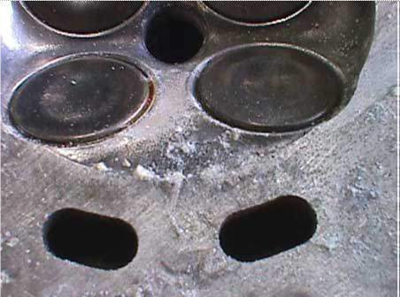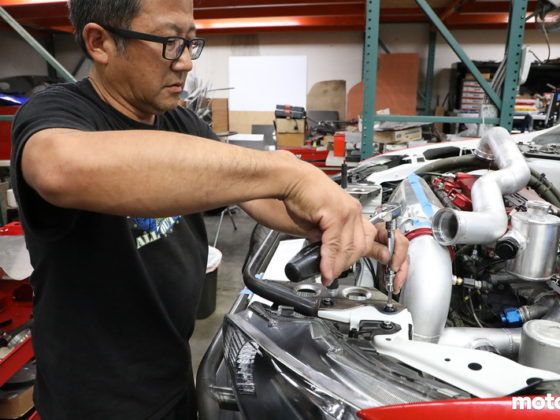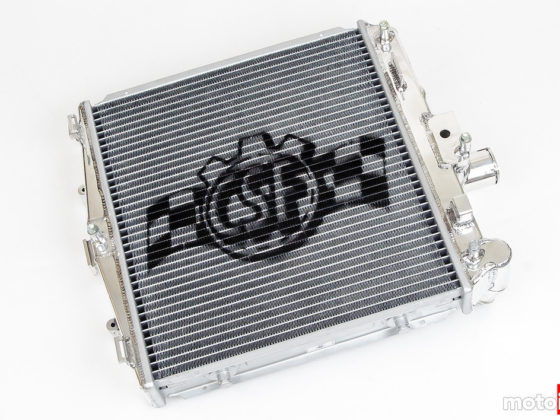Why get even more depressed? The intake was noisy just like the exhaust port. I opened the intake valve to the same 0.600” valve lift as I had all of the other tests. The results were like that of the exhaust port. The Original heads lightly ported exhaust port was much better than this new “ported” and finished intake port. This was ridiculous! I could not in good conscience subject my wife or the neighborhood stray cat to any additional sad flow bench graphs. So, I headed for the computer and started this article instead.

Finished Intake port from Well-Known shop. No extra charge for the corrosion on the valves.

Finished RMI Intake port
I mentioned that I opened the valves to 0.600 of an inch lift. The camshaft will not be lifting the valves that far in this application. However, there is a reason that I lift the valves in any cylinder head test beyond what the camshaft will be lifting them to. Air is a fluid. It behaves in a similar manner to water– but their mass, atomic structure, (Reynolds number-Ed)surface tension, and temperature of operation are usually different. So, there are differences in how they react which is based upon these and more variations.
Any fluid has mass, weight and while in motion, a velocity. So even though your valves will only be, for example, opening up to 0.500 thousandths of an inch valve lift, a good port runner should be able to handle the accelerating air flow beyond the port’s maximum valve lift. The fuel and air charge in port runners do not come to a screeching halt like the Road Runner when the valve closes. That air/fuel charge has mass, energy and velocity. It better have, or you will never fill the combustion chamber up to or past 100 percent Volumetric Efficiency or VE. Any operating intake valve, no matter the make or model or size of the engine, is only open for micro seconds in any IC engine.
If the port will not handle charge flow above the max cam lift, then airflow is impeded below full lift in the port runner. The port will choke primarily due to Turbulence in the port runner. The now turbulent charge in the port will back up the next incoming charge. This is just one reason that port shape and port runner wall surface is so important.

Close up of “finished” High Performance cylinder head job from Nationally known shop. The cylinder head was delivered to customer like this.

Close up of another combustion chamber from the “finished” cylinder head above. Yes, that is rust and rust blisters on the valve faces. Never figured out what all that fuzzy white shit was.
Part Two
Baffle em With Bullshit!
Yes! Our V-8 Engine RV Camshaft will work Great in your Toyota MR-2!
We can all be guilty of Intellectual Sloth. When it comes to the Internet, if it’s on our screen, it must be good! Many sites advertise the latest and greatest. Products guaranteed to make your teeth whiter and lift your valves higher. The high performance and racing engine businesses can be and often is just as full of shit as any politician or any other segment of society. An Online presence does not mean that a person or company knows what they are doing or that they produce quality work.
Camshafts are probably the worst and most abused Marketing item in the automotive industry aftermarket. A camshaft is a mechanical timing device which controls the engine’s valve train. A camshaft is timed to operate in conjunction with the engine’s crankshaft in rotational degrees and the piston’s location within the cylinder. This timing of the camshaft/valves to the crankshaft degrees and piston location applies to pneumatically controlled or computer-controlled valves as well. A camshaft with a bit more lift and duration will usually increase your engine’s performance in one area of the engine’s power band. But does that increase happen where your engine can utilize it? A 6,000 to 8,000 RPM power-band for your Mom’s Honda Civic will not please your Mom or the Civic. You want your engine and vehicle to operate in its most efficient range. You therefore want to increase its “usable” power-band. You can consult your friends and “A Guy who Knows” on the Internet. Or, you could speak to someone with experience–there’s that word again–who actually knows camshafts. You know, a professional. They will need a few questions answered before they can fully help you. One of the most important is “what is the air flow capabilities of your cylinder heads”?




20 comments
in your opinion, how does a reasonably informed person that does all their own work find a company (generally in another state) to perform tasks that the average person cant due to time/tools/knowledge etc. apart from reading reviews and looking at websites, can accomplishments even speak for a company (fastest this, highest hp that)?
great article!!!
Talk to local club racers who aren’t sponsored. A general consensus will leaf you to a few, then interview the shops to see which one seems like the right fit for you.
Thanks!!
Good advice…see my response to the first comment.
Than you, Don
I would look at what results people get with products or services.
thats kind of been my mo so far
Hello Wes, and others. Thank you for the comments.
These comments have brought up some excellent points. Where do you get machine work done? As the world has evolved (?) into a Wal-Mart mentality. Don’t fix it. Just throw it away and buy a brand new and less expensive model mentality. There are fewer and fewer automotive machine shops still in operation. As few schools teach “Industrial Arts” such as Machine, Metal or Wood Shop any longer. Few students/young people get an introduction to any type of Blue Collar occupations. So fewer young people get involved or learn trades in order to replace an aging work force. Hence a lack of Automotive Machine Shops in the US. To the best of my knowledge there are now only two full service automotive machine shops in our entire county. Be aware!!! Street and Racing Automotive machining requires different operator mentality and different machine and shop quality. They are two different things with two different levels of craftsmanship and tolerances.
If you are into “Street/Track” orientated cars. I would suggest attending local Cars and Coffee event in your area. Most car/bike people are approachable and willing to share knowledge.
If you are into various forms of racing, Drags, Road-Racing, Drifting, Land-Speed Racing. Whatever. Attend events in your area.
For example; Here in California there are many different Drag Race events. California’s NHRA Division 7 holds a number of two day events yearly. Pick an event, attend and walk around. See who has a car or bike like yours or one that you would like to build. BUT!!! Do Not go on Race day and expect people to stop what they are doing to talk to you. No matter the type of racing that you do or that you want to be involved in. Go on the first day of a two day event when applicable. People will be much more relaxed, approachable and more willing to talk.
Circle Track type events only allow fans into the Pits to talk to drivers/crew after the race is over. No matter the event type. Cary pen and paper with you to write down information. Formulate your questions BEFORE you speak. “Would you mind telling me who does your engine work? Would you have their contact information?” Etc. Above all no matter the type of racing or event. Be polite and listen. When you are trying to get information, do not attempt to convince the people that you are speaking to how “Bitchin” you and your car/motorcycle are. SHUT UP and LISTEN
Thanks, Don
This is what i did when i was tracking sportbikes. it just so happend a well respected shop happened to be where i live (charleston). But as i embark on rebuilding my old honda into something respectable for an old guy (37 lol), the shops around me focus on big block 1/8th mile drag cars and therefore aren’t familiar with 90 japanese engines. Thanks again!!
Thank you Wes,
That is a problem that one encounters with most automotive machine shops when trying to get machine work on motorcycle engines. Most automotive machines were not designed to accept motorcycle engines. Additionally most automotive machinist are not used to working or have the finesse to work on smaller and more exacting engines. That is why I made the comment about Street Shops and Racing Shops. There are differences.
Don
While using a local, to your area machine shop is convenient. Our national shipping systems are reasonably competent when it comes to moving packages and goods from one place or one state to another.
A lot of my work comes from outside my area and out of my state. There are fewer shops in the country now due to reasons that I have listed previously.
High end shops are becoming harder to find. Unfortunately, the days of the corner machine shop are pretty much over. Back when I was a kid and the Flintstones were real.
Auto machine shops usually drag or circle track raced a car. Local motorcycle shops Flat Tracked, Road Raced or raced Rough Scrambles. That was a few years before Motocross appeared.
In other words. Shops were owned and operated by ENTHUSIAST!
The price of the machines now required to machine engines has risen exponentially. Any good CNC machine is $100,000.00. The high end machines are double to triple that.
A shop needs to process a LOT of work to pay for these machines and the personnel to operate them. Spare time to work on shop projects and race vehicles becomes a premium.
So, as Mike said absolutely educate yourself. The more that you know and understand, the less likely your chances of being ripped off and the faster and more reliable your vehicle will become.
Attending race events is also educational if you are serious when you go there and study and observe.
Get off your cell phone and read some BOOKS!!! David Vizard, Harold Bettes and others have numerous books on race engine blueprinting, engine machining of blocks, cylinder head work, improvements and testing, etc.
The SAME machining and assembly procedures that are used to Blueprint a 350 Chevy V-8 apply to a Honda inline 4 or an RB-26 inline 6 or a Suzuki GSX-R1000, etc.
Our brains process written and on-line information differently. You Tube videos are NOT books.
The proliferation of “Experts” on You Tube is ridiculous and far often miss-leading. Owning a cell phone that can video does not make you an expert.
The 2016 election of the Insane Klown Pose to the executive branch should prove that.
Don
I would just do the hard time and learn it the proper way: Educate yourself with the right education en literature. And in case your generation Y (read: WHY ) set up the serveice terms in advance before buying. A good company stands by their own products. In a sense they should be proud of what they’re doing. So if there is a mishap in quality control, after showing them what you got, they should acknowledge it. So for something thats done the right way the testing mishaps around the SSC Tuatara.
Have seen plenty of these mistakes in my lifetime, so you can count me in on the angry old dudes clubs.
As for the white stuff: Thats most likely calicification from cleaning using tap water with high amounts of chalk, limestone/gypsum. In general: “Hard Water”. It would also explain the rust bubbles
Hi KS and thank you,
Gen Y or any other Generation has to learn and that takes time as does experience. My hope for all of the articles that I write is to pass on some of what I have learned in now 45 years in this profession. To also encourage younger people learn and spend the time necessary to gain experience. So while the focus of my response was about finding a good machine shop. I know that while attending racing events that young people will learn via observation, listening and thinking about what they are seeing.
I have no real knowledge of Drifting. But were there a need for me to gain more knowledge of this segment of motorsports. I would attend a few Drifting events. Observe and ask questions. So my suggestion is to do what I would still do.
The “white fuzz” and rust was more pronounced in person than what is evident in the photograph. I took those pictures back in 2002 with an early generation digital camera. How Mike and company were able to resurrect them is a minor miracle. When I first saw the cylinder head. My first reaction was that they left the head sit outside in Ohio or some other rust belt stat over the winter. Regardless, what sort of a company sends out a “Finished” cylinder head like that to a customer?
Don
Not the right company, but most likely a company of more then one person, but not a big company that has quality control. Or its a very large company where the old adage goes: Pay peanuts, get monkeys! In other words: an unmotivated workforce.
When you use water on heads but dont dry them and leave the out to dry on their own thats what will happen. Im guessing its mostly on one side. Have seen that heaps of time on my side of the pond.
As for writing and passing on the info: I hear you, but as far as i can tell the current generation isnt really up for that anymore: Instant gratification is the key word. “I want it, i want it now, and i dont want to think about it. “Thats what sums it up…. To me it seams that after about 1988 that mentality started to change. Let alone the mentality know.
Hey I was going through a tough time when I did that work. My dog had just broken up with my and my girlfriend ran away so it was hard to focus at work. Give a guy a break!
Sorry to hear that. I hope that your dog is better now.
Don
Hi Don, would you please qualify your comment: “To the best of my knowledge there are now only two full service automotive machine shops in our entire county.”
There are lots of shops that do head and cylinder work, so are the operative words in your statement “full service?” In other words, there are only 2 shops in the US that have the ability to service/machine every single component on your car? E.g., “We are a shop that does every single type of engine work you can think of – head work and even rewelding/machining crank main journals plus transmission work.” Or, what do you mean when you say “full service?”
Hello tbasic1 and thank you for your comment,
County as in LA County, San Diego County, Travis County, etc. Not Country.
In the county that I live in. There previously were approximately six (6) full service automotive machine shops in this county. There are now only two full service shops and two partial service auto machine shops. The partial service machine shops machine brake rotors and drums, some will perform single angle valve jobs, etc. This is not full service.
Full Service to me is having the machinery and the ability to bore and (properly) home an engine block. Surface blocks and cylinder head and properly do multi angle valve jobs, etc.
I hope that this clarifies what I wrote.
Don
Doh! Thanks for the clarification, Don. I did indeed misread.
I’d honestly like to know what the machine shops said when the photos/flow numbers were sent there way with a “WTF?” message with it.
What’s their response to being called out for their shabby work?? Because I know I’d call them out for it…especially so with it being a $$$$ expenditure.
Hello Superstar!!!
The shop was not contacted by us but the customer may have spoken to them. I was asked to look at the head but was not directly involved with the customer.
My friends at the machine shop where that customer initially took the cylinder head, fixed the problems. They cleaned up the cylinder head, blasted the rust and gunk off then steam cleansed it.
I do not remember if they had to redo the valve job but I am pretty sure that they did perform a very light resurface pass on the cylinder head deck.
Modern head gaskets do not like decks that resemble giant grooves from 33 and 1/3 LP’s or a piece of rough cut lumber.
Don